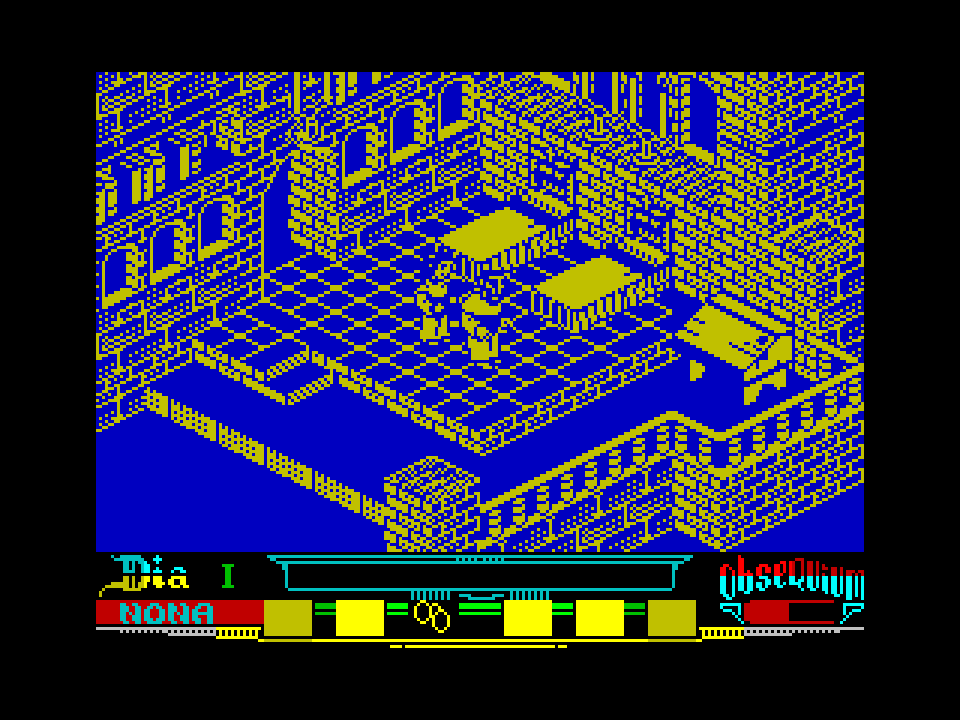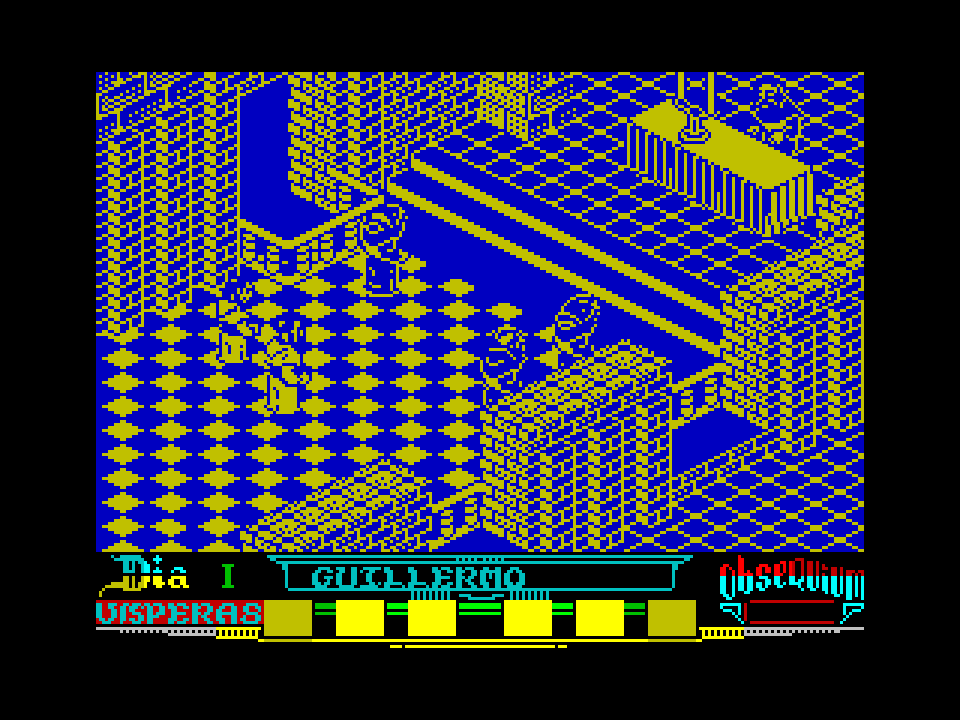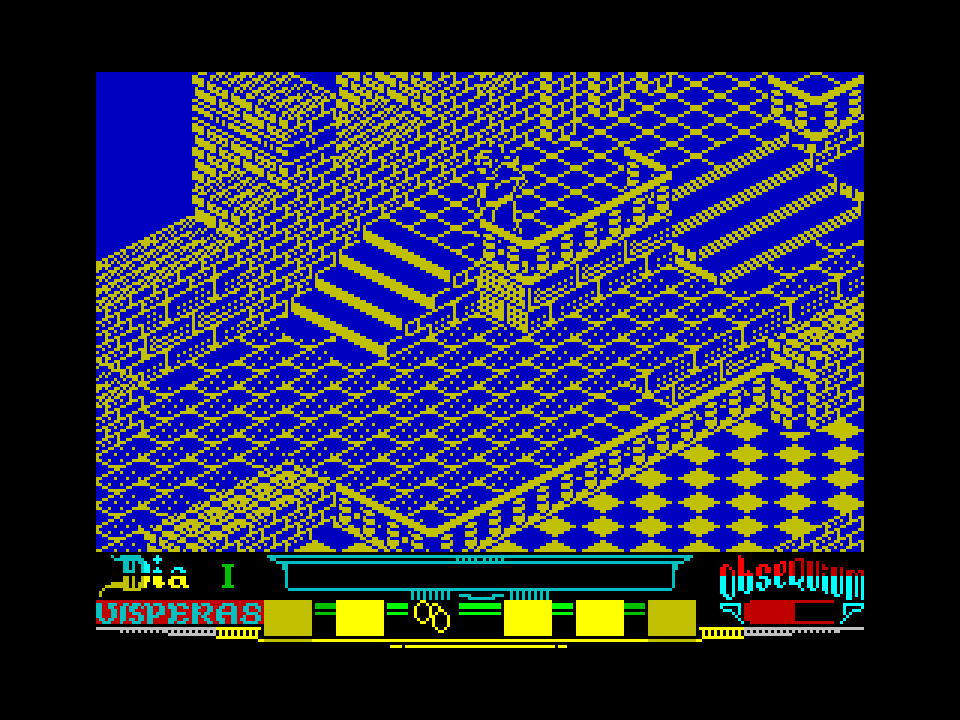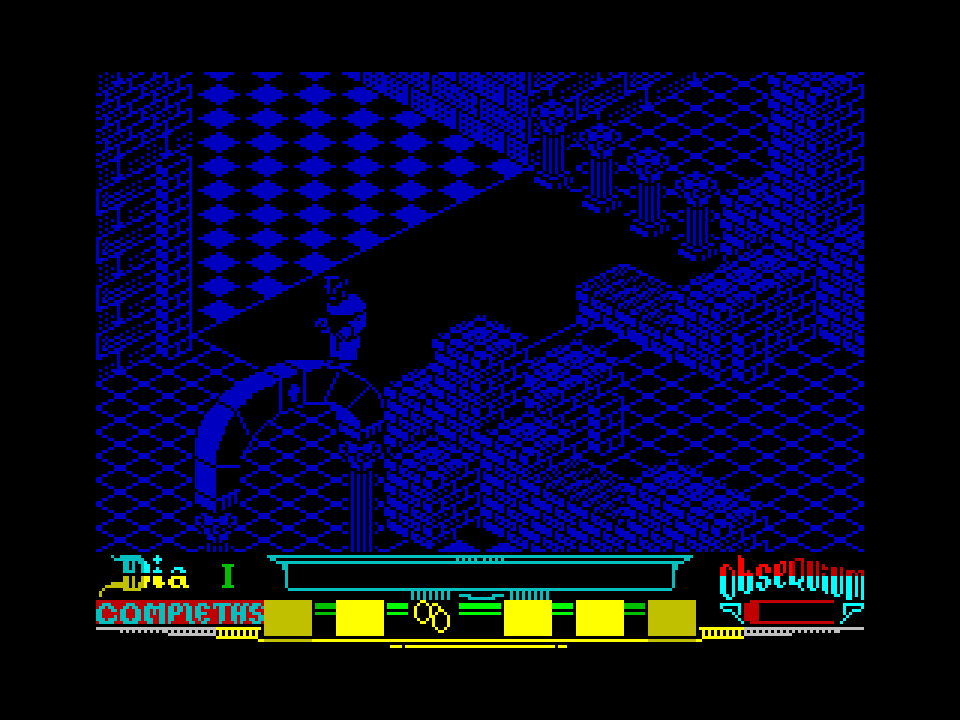La Abadía Del Crimen Review
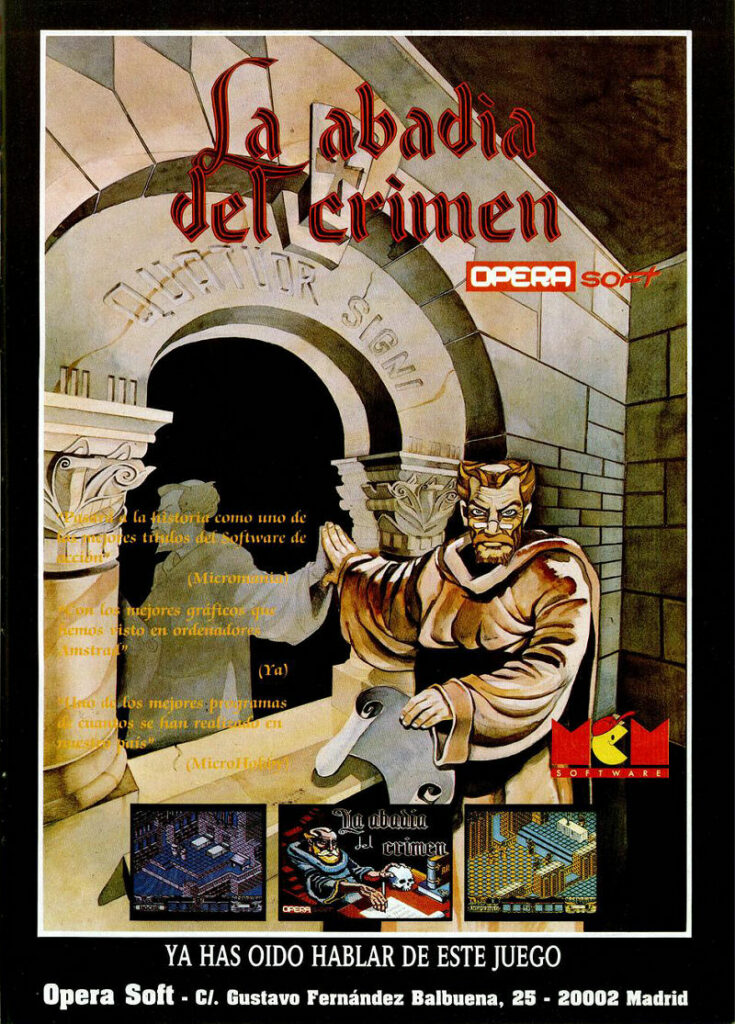
An adventure / mystery game in Spanish (Although an unofficial English translation does exist.), based on Umberto Eco’s novel “The Name Of The Rose”. For the ZX Spectrum 128K only.
STORY
It has been called “The Great Escape set in a European medieval monastery.” And it has been called one of the best ZX Spectrum games on the market. Unfortunately, it was never released outside Spain at the time. “The Great Escape”-reference would naturally be to Denton Designs’ game and not the movie. Publisher Opera Soft was sort of like Spain’s answer to Imagine or Ocean Software in their heydays, and they released games like Cosa Nostra, the “Livingstone Supongo?”-games, Mot, Sol Negro, Soviet, etc. The list is long. Fate “or something” brought together Francisco “Paco” Menéndez (R.I.P.) and Juan Delcán to develop La Abadía Del Crimen. (Which would translate to “The Abbey Of Crime” in English.) Opera Soft tried to get the permission to use the name of Eco’s novel for the game, but that didn’t happen for some reason.
Not that a game of La Abadía Del Crimen’s caliber needs a title of a more popular novel or movie title to get recognized. Because it’s one strangely intriguing and interesting game.
Fray “Master” Guillermo and his partner in crime-solving, Adzo, has been called to the abbey of St. Benedict to investigate the disappearance of Venancio – One of the monks. It’s almost immediately revealed (For the sake of the plot.) that Venancio has been murdered and that his killer logically must be someone living in the abbey. Guillermo and Adzo have seven days to solve the crime, because that’s when Big Shot Inquisitor Bernardo Giu arrives. If the case isn’t closed by then, the reputation of the place goes down the toilet…
But until then, of course, the murder becomes murders as the plot thickens and old secrets are unearthed…
THE GAME
La Abadía Del Crimen is an isometric view flip-screen adventure game set in this fairly large abbey and two “secret places”. In most games in this sub-genre, you exit on one side of the screen and appear on the next one on the opposite side. Which isn’t always the case here – You could for example exit at the bottom of the screen and enter the next one from the left side. (It’s a slightly unusual layout, but you get used to it in no time. And it is possible to draw a map of the place.)
You control Guillermo and, to some extent, Adzo. (The dynamic duo mostly stays on the same screens.) A murder investigation in an abbey? Why should that be harder there than in the streets since the killer most likely is one of the monks? Because you can’t just go anywhere you want at any time. There are rules to follow, and the Abbot who welcomes you at the beginning of the game is quick to point out that Guillermo must respect the Order and its rules. This means: Eat when you’re told to eat. Sleep when you’re told to sleep. Shit– No… But visit the church during service. Always.
Venancio’s body isn’t found until the second day. The first day is more or less wasted anti-chilling as you just check out your room and go to the church to pray the rest of the night. It’s not until “Día II” some interesting stuff starts happening. The days are divided into Canonical Hours (Noche, Prima, Tercia, Sext, Nona, Vísperas, and Completas.), so there is the “same” real-time aspect as in The Great Escape.
On screen is that red “Obsequium”-bar (Obsequium would be Latin for “obedience” or “compliance”.), which drops pretty goddamn rapidly if you don’t obey the strict regulations. You’re immediately reminded of its function as the Abbot escorts you to your sleeping quarters. You literally have to follow him as closely as possible. Stroll down the wrong steps or try to walk ahead of him, and the Obsequium-bar shrinks like when it’s cold. It’s so very easy to screw up here, and once the Obedience-level drops to zero, your ass is thrown out head first. The same happens if you’re not sleeping at night but are caught sneaking around where you’re not supposed to be. After your disgraceful exit / Game Over, you’re informed of how many percent of the investigation you managed to complete.
Shorter messages and words spoken by the various characters scroll in a separate window above the inventory. (Note that they can’t be repeated.)
CONTENT
When the game has loaded, it begins with an animated journal. (Looking like an invisible pen writing the text on the turning pages.) This segment goes on for seven minutes (!) and can fortunately be skipped. (But it provides a very good background for the game. And if you love reading, the visually identical ending is twelve minutes!)
The abbey is divided into three sections, and while La Abadía Del Crimen is nowhere near the biggest game in this sub-genre (No game is Denton Designs’ Where Time Stood Still.), there are quite a few screens (Many of them showing parts of “adjacent” screens from another angle.) and it is possible to get slightly lost at first. Memorizing the layout of the monastery becomes almost necessary as you don’t have time to wander around casually while looking for your quarters – Especially not in the middle of the night when you have to remain absolutely undetected.
No. You won’t crack the case on the first tries either. Even if you know what you’re doing and know what you have to do, there are numerous times everything can go straight down the shitter. When the bloody Abbot has to “order you to follow [him]” for the tenth time, you’re in big trouble…
CONTROLS
Keys or Joystick. With the former option, Guillermo is controlled with three keys, basically. “K” for turning right in a 90-degree angle, “L” for turning left (ditto), and “A” for walking in the direction Guillermo is facing. Adzo can be controlled separately by pressing “Z” first, or by pushing down on the Joystick.
Guillermo automatically picks up items (Keys, scrolls, etc.) that he stands close to. (He can carry six at most at a time.) Dropping items from the inventory is done with the Space-key.
As this is a game that you probably won’t play from the beginning and non-stop until it’s done, you might want to save your progress every now and then. The software utilizes both traditional and RAM-saves. (With nine slots.)
GRAPHICS
It’s the interiors of St. Benedict in meticulous detail – Contrasting colors like yellow and blue during daytime, and tremendously atmospheric near-pitch black with blue at nights. There is quite a bit of variation around the abbey, which makes it easier to memorize where the stairs are and where all the halls and corridors lead.
As expected (More or less.), there are some frame-rate drops when half a dozen characters move about on one screen. Fortunately, this doesn’t happen all too often. At least not often enough to make the controls or gameplay frustrating.
SOUND
Time to crank some Johann Sebastian Bach…! Just like they didn’t have live bands providing suitable mood music around the clock at abbeys, we don’t get sampled organ music in this version of the game. But there is always some lovely chip-music – According to Wikipedia, the Bach numbers are “The Minuet In G Major” and “Flute Sonata In C Major, BWV 1033”. The tune that starts playing when you don’t move Guillermo for a couple of moments, is a rendition of “Crystal Palace” by French experimental folk music group Gwendal.
As for sound effects, there are barely any. (And they aren’t really needed.)
SUMMARY
The similarities to The Great Escape aren’t obviously many. But if you absolutely loved the format, the pace of the game, and at the same time don’t mind doing some detective work, La Abadía Del Crimen is a given choice. (Because you will be sneaking at St. Benedict too – That’s guaranteed…!) And as mentioned, there is an English version if you don’t speak Spanish.
Note: Sadly, Paco Menéndez committed suicide in 1999, merely 34 years young.
The game was translated into English by Eddie Duffy.
Developed by: Paco Menéndez and Juan Delcán.
Published by: Opera Soft
Version Reviewed: ZX Spectrum 128K
Genre: Adventure
Players: 1
Also Available On: Amstrad CPC, MSX
Released: 1988

